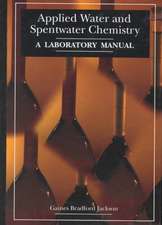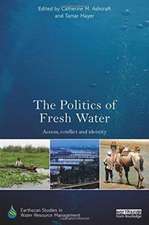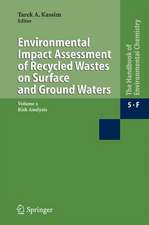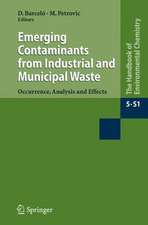Ancient Water Technologies
Editat de L. Maysen Limba Engleză Paperback – 12 noi 2014
It provides an overview of the water technologies developed by a number of ancient civilizations, from those of Mesopotamia and the Indus valley to later societies such as the Mycenaeans, Minoans, Persians, and the ancient Egyptians. Of course, no book on ancient water technologies would be complete without discussing the engineering feats of the Romans and Greeks, yet as well as covering these key civilizations, it also examines how ancient American societies from the Hohokams to the Mayans and Incas husbanded their water supplies. This unusually wide-ranging text could offer today’s parched world some solutions to the impending crisis in our water supply.
"This book provides valuable insights into the water technologies developed in ancient civilizations which are the underpinning of modern achievements in water engineering and management practices. It is the best proof that "the past is the key for the future."
Andreas N. Angelakis, Hellenic Water Supply and Sewerage Systems Association, Greece
"This book makes a fundamental contribution to what will become the most important challenge of our civilization facing the global crisis: the problem of water. Ancient Water Technologies provides a complete panorama of how ancient societies confronted themselves with the management of water. The role of this volume is to provide, for the first time on this issue, an extensive historical and scientific reconstruction and an indication of how traditional knowledgemay be employed to ensure a sustainable future for all."
Pietro Laureano, UNESCO expert for ecosystems at risk, Director of IPOGEA-Institute of Traditional Knowledge, Italy
| Toate formatele și edițiile | Preț | Express |
|---|---|---|
| Paperback (1) | 1109.02 lei 6-8 săpt. | |
| SPRINGER NETHERLANDS – 12 noi 2014 | 1109.02 lei 6-8 săpt. | |
| Hardback (1) | 1116.29 lei 6-8 săpt. | |
| SPRINGER NETHERLANDS – 19 iun 2010 | 1116.29 lei 6-8 săpt. |
Preț: 1109.02 lei
Preț vechi: 1352.46 lei
-18% Nou
Puncte Express: 1664
Preț estimativ în valută:
212.24€ • 219.25$ • 176.64£
212.24€ • 219.25$ • 176.64£
Carte tipărită la comandă
Livrare economică 25 martie-08 aprilie
Preluare comenzi: 021 569.72.76
Specificații
ISBN-13: 9789400793361
ISBN-10: 9400793367
Pagini: 292
Ilustrații: XII, 280 p.
Dimensiuni: 155 x 235 x 15 mm
Greutate: 0.45 kg
Ediția:2010
Editura: SPRINGER NETHERLANDS
Colecția Springer
Locul publicării:Dordrecht, Netherlands
ISBN-10: 9400793367
Pagini: 292
Ilustrații: XII, 280 p.
Dimensiuni: 155 x 235 x 15 mm
Greutate: 0.45 kg
Ediția:2010
Editura: SPRINGER NETHERLANDS
Colecția Springer
Locul publicării:Dordrecht, Netherlands
Public țintă
ResearchCuprins
A Brief History of Water Technology During Antiquity: Before the Romans.- Water Technology in Ancient Mesopotamia.- Water Technology in Ancient Egypt.- Ancient Greek Lavatories: Operation with Reused Water.- Water Resource Management for Iran’s Persepolis Complex.- A Web Based Information System for the Inspection of the Hydraulic Works in Ancient Greece.- A Brief History of Roman Water Technology.- Analysis of the Water System of the Ancient Roman City of Apamea.- Water Technology in the Ancient American Societies.- Ground Water Resources and Earthquake Hazards: Ancient and Modern Perspectives.- Lessons from the Ancients on Water Resources Sustainability.
Notă biografică
About the Author:
Larry W. Mays, Ph.D., P.E., P.H., D. WRE, is Professor of Civil and Environmental Engineering at Arizona State University, and former chair of the department. He was formerly Director of the Center for Research in Water Resources at the University of Texas at Austin, where he held an Engineering Foundation–endowed professorship. A registered professional engineer in several states, and a registered professional hydrologist, he has served as a consultant to many organizations.
Professor Mays is the author of Water Resources Engineering (published by John Wiley & Sons, Inc.) and Optimal Control of Hydrosystems (published by Marcel Dekker), and co-author of Applied Hydrology and Hydrosystems Engineering and Management (both from McGraw-Hill)and Groundwater Hydrology (published by John Wiley & Sons, Inc). He was editor-in-chief of Water Resources Handbook, Water Distribution Systems Handbook, Urban Water Supply Management Tools, Stormwater Collection Systems Design Handbook, Urban Water Supply Handbook, Urban Stormwater Management Tools, Hydraulic Design Handbook, and Water Supply Systems Security, and Water Resources Sustainability, all published by McGraw-Hill. In addition, he is editor-in-chief of Reliability Analysis of Water Distribution Systems and co-editor of Computer Methods of Free Surface and Pressurized Flow. Professor Mays’ most recent book is Urban Water Management in Arid and Semi-arid Regions, published by Taylor and Francis. This book was the result of volunteer work for the United Nations UNESCO-IHP in Paris.
Professor Mays has published extensively in refereed journal publications and papers in the proceedings of national and international conferences, many of which were invited papers, and many invited chapters in books that he did not author or edit. Among his honors is a distinguished alumnus award from the University of Illinois at Champaign-Urbana and he is a Diplomate,Water Resources Engineering of the American Academy of Water Resources Engineering. He is also a Fellow of the American Society of Civil Engineers and the International Water Resources Association. Professor Mays lives in Mesa, Arizona and Pagosa Springs, Colorado.
Larry W. Mays, Ph.D., P.E., P.H., D. WRE, is Professor of Civil and Environmental Engineering at Arizona State University, and former chair of the department. He was formerly Director of the Center for Research in Water Resources at the University of Texas at Austin, where he held an Engineering Foundation–endowed professorship. A registered professional engineer in several states, and a registered professional hydrologist, he has served as a consultant to many organizations.
Professor Mays is the author of Water Resources Engineering (published by John Wiley & Sons, Inc.) and Optimal Control of Hydrosystems (published by Marcel Dekker), and co-author of Applied Hydrology and Hydrosystems Engineering and Management (both from McGraw-Hill)and Groundwater Hydrology (published by John Wiley & Sons, Inc). He was editor-in-chief of Water Resources Handbook, Water Distribution Systems Handbook, Urban Water Supply Management Tools, Stormwater Collection Systems Design Handbook, Urban Water Supply Handbook, Urban Stormwater Management Tools, Hydraulic Design Handbook, and Water Supply Systems Security, and Water Resources Sustainability, all published by McGraw-Hill. In addition, he is editor-in-chief of Reliability Analysis of Water Distribution Systems and co-editor of Computer Methods of Free Surface and Pressurized Flow. Professor Mays’ most recent book is Urban Water Management in Arid and Semi-arid Regions, published by Taylor and Francis. This book was the result of volunteer work for the United Nations UNESCO-IHP in Paris.
Professor Mays has published extensively in refereed journal publications and papers in the proceedings of national and international conferences, many of which were invited papers, and many invited chapters in books that he did not author or edit. Among his honors is a distinguished alumnus award from the University of Illinois at Champaign-Urbana and he is a Diplomate,Water Resources Engineering of the American Academy of Water Resources Engineering. He is also a Fellow of the American Society of Civil Engineers and the International Water Resources Association. Professor Mays lives in Mesa, Arizona and Pagosa Springs, Colorado.
Textul de pe ultima copertă
There is no more fundamental resource than water. The basis of all life, water is fast becoming a key issue in today’s world, as well as a source of conflict. This fascinating book, which sets out many of the ingenious methods by which ancient societies gathered, transported and stored water, is a timely publication as overextraction and profligacy threaten the existence of aquifers and watercourses that have supplied our needs for millennia.
It provides an overview of the water technologies developed by a number of ancient civilizations, from those of Mesopotamia and the Indus valley to later societies such as the Mycenaeans, Minoans, Persians, and the ancient Egyptians. Of course, no book on ancient water technologies would be complete without discussing the engineering feats of the Romans and Greeks, yet as well as covering these key civilizations, it also examines how ancient American societies from the Hohokams to the Mayans and Incas husbanded their water supplies. This unusually wide-ranging text could offer today’s parched world some solutions to the impending crisis in our water supply.
It provides an overview of the water technologies developed by a number of ancient civilizations, from those of Mesopotamia and the Indus valley to later societies such as the Mycenaeans, Minoans, Persians, and the ancient Egyptians. Of course, no book on ancient water technologies would be complete without discussing the engineering feats of the Romans and Greeks, yet as well as covering these key civilizations, it also examines how ancient American societies from the Hohokams to the Mayans and Incas husbanded their water supplies. This unusually wide-ranging text could offer today’s parched world some solutions to the impending crisis in our water supply.
Caracteristici
Presents a universal picture of water technologies of ancient civilizations An unusually wide-ranging text which could offer today’s world solutions to the impending crisis in our water supply





















